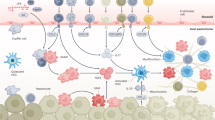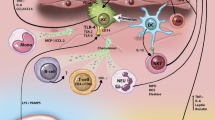Abstract
Background
Nonalcoholic steatohepatitis (NASH) is a chronic inflammatory liver disease influenced by risk factors for the metabolic syndrome. In adult patients, NASH is associated with an altered phenotype and functionality of peripheral immune cells, the recruitment of leukocytes and intrahepatic activation, and an exacerbated production of reactive oxygen species (ROS) and cytokines. It remains unclear if the previously described differences between pediatric and adult nonalcoholic fatty liver diseases also reflect differences in their pathogenesis.
Aims
We aimed to investigate the phenotype and functionality of circulating immune cells and the potential contribution of liver infiltrating leukocytes to the immunological imbalance in pediatric NASH.
Results
By a real-time PCR-based analysis of cytokines and immunohistochemical staining of liver biopsies, we demonstrated that the hepatic microenvironment is dominated by interferon-gamma (IFN-γ) but not interleukin-4 and is infiltrated by a higher number of CD8+ cells in pediatric NASH. The number of infiltrating neutrophils positively correlated with ROS generation by peripheral polymorphonuclear cells. By a flow cytometric analysis of peripheral blood lymphocytes, a distinctive increase in CD8+ CD45RO and CD8+ CD45RA subpopulations and an increased production of IFN-γ by CD4+ and CD8+ cells were shown. The production of ROS following PMA stimulation was augmented in circulating neutrophils but not in monocytes.
Conclusion
In sum, the distinctive phenotype and functionality of infiltrating and circulating cells suggest that the role of innate cells is coupled to a Th1-polarized immune response in pediatric NASH.




Similar content being viewed by others
References
Paschos P, Paletas K. Non alcoholic fatty liver disease and metabolic syndrome. Hippokratia. 2009;13:9–19.
Vuppalanchi R, Chalasani N. Non-alcoholic fatty liver disease and non-alcoholic steatohepatitis: past, present and future directions. J Gastrointestin Liver Dis. 2010;19:415–23.
Brunt EM. Pathology of nonalcoholic steatohepatitis. Hepatol Res. 2005;33:68–71.
Brunt EM. Histopathology of non-alcoholic fatty liver disease. Clin Liver Dis. 2005;13:533–44.
Day C, James OFW. Steatohepatitis: a tale of two “hits”? Gastroenterology. 1998;114:842–5.
Basaranoglu M, Kayacetin S, Yilmaz N, Kayacetin E, Tarcin O, Sonsuz A. Understanding mechanisms of the pathogenesis of nonalcoholic fatty liver disease. World J Gastroenterol. 2010;16:2223–6.
Fassio E, Alvarez E, Dominguez N, Landeira G, Longo C. Natural history of nonalcoholic steatohepatitis: a longitudinal study of repeat liver biopsies. Hepatology. 2004;40:820–6.
Jasen PML. Nonalcoholic steatohepatitis. J Med. 2004;62:217–24.
Pascale A, Pais R, Ratziu V. An overview of nonalcoholic steatohepatitis: past, present and future directions. J Gastrointestin Liver Dis. 2010;19:415–23.
Tominaga K, Fujimoto E, Suzuki K, Hayashi M, Ichikawa M, Inaba Y. Prevalence of non-alcoholic fatty liver disease in children and relationship to metabolic syndrome, insulin resistance, and waist circumference. Environ Health Prev Med. 2009;14:142–9.
Argo CK, Caldwell SH. Epidemiology and natural history of non-alcoholic steatohepatitis. Clin Liver Dis. 2009;13:511–31.
Frith J, Jones D, Newton J. Chronic liver disease in an ageing population. Age Ageing. 2009;38:11–8.
Singh R, Bullard J, Kalra M, Assefa S, Kaul AK, Vonfeldt K, et al. Status of bacterial colonization, Toll like receptor expression and nuclear factor-kappa B activation in normal and diseased human livers. Clin Immunol. 2011;138:41–9.
Jaeschke H, Gores GJ, Cederbaum AI, Hinson JÁ, Pessayre D, Lemasters JJ. Mechanisms of hepatotoxicity. Toxicol Sci. 2002;65:166–76.
Buffy G. Kupffer cells in non-alcoholic steatohepatitis: the emerging view. J Hepatol. 2009;51:212–23.
Seki S, Kitada T, Yamada T, Sakaguchi H, Nakatani K, Wakasa K. In situ detection of lipid peroxidation and oxidative DNA damage in non-alcoholic fatty liver diseases. J Hepatol. 2002;37:56–62.
Abdelmalek MF, Diehl AM. Mechanisms underlying nonalcoholic steatohepatitis. Drug Discov Today: Dis Mech. 2006;3:479–88.
Schwimmer JB, Behling C, Newbury R, Deutsch R, Nievergelt C, Schork NJ, Lavine JE. Histopathology of pediatric nonalcoholic fatty liver disease. Hepatology. 2005;42:641–9.
Rensen SS, Slaats S, Nijhuis J, Jans A, Bieghs V, Driessen A, Malle E, Greve JW, Buurman WA. Increased hepatic myeloperoxidase activity in obese subjects with nonalcoholic steatohepatitis. Am J Pathol. 2009;175:1473–82.
Adler M, Taylor S, Okebugwu K, Yee H, Fielding C, Fielding G, Poles M. Intrahepatic natural killer T cell populations are increased in human hepatic steatosis. World J Gastroenterol. 2011;17:1725–31.
Li QF, Li YP, Cheng PS. Peripheral T-lymphocyte subsets changes in patients with endocrine and metabolic diseases. Zhonghua Nei Ke Za Zhi. 1989;28:410–2.
Romo EM, Muñoz-Robles JA, Castillo-Rama M, Meneu JC, Moreno-Elola A, Perez-Saborido B, et al. Peripheral blood lymphocyte populations in end-stage liver diseases. J Clin Gastroenterol. 2007;41(7):713–21.
Inzaugarat ME, Ferreyra Solari NE, Billordo LA, Abecasis R, Gadano AC, Cherñavsky AC. Altered phenotype and functionality of circulating immune cells characterize adult patients with nonalcoholic steatohepatitis. J Clin Immunol. 2011;31:1120–30.
Kleiner DE, Brunt EM, Van Natta M, Behling C, Contos MJ, Cummings OW, Ferrell LD, Liu YC, Torbenson MS, Unalp-Arida A, Yeh M, McCullough AJ, Sanyal AJ. Design and validation of a histological scoring system for nonalcoholic fatty liver disease. Hepatology. 2005;41:1313–21.
Brunt EM, Janney CG, Di Bisceglie AM, Neuschwander-Tetri BA, Bacon BR. Nonalcoholic steatohepatitis: a proposal for grading and staging the histological lesions. Am J Gastroenterol. 1999;94:2467–74.
Cole TJ, Bellizzi MC, Flegal KM, Dietz WH. Establishing a standard definition for child overweight and obesity worldwide: international survey. BMJ. 2000;320:1–6.
De Basio MB, Periolo N, Avagnina A, Garcia de Davila MT, Ciocca M, Goñi J, de Mateeo E, Galoppo C, Cañero-Velasco MC, Fainboim H, Muñoz AE, Fainboim L, Cherñavsky AC. Liver infiltrating mononuclear cells in children with type 1 autoimmune hepatitis. J Clin Pathol. 2006;59:417–23.
Lalor PL, Shields P, et al. Recruitment of lymphocytes to the human liver. Immunol Cell Biol. 2002;80:52–64.
Lemmers A, Moreno C, Gustot T, et al. The interleukin-17 pathway is involved in human alcoholic liver disease. Hepatology. 2009;49:646–57.
Berard M, Tough DF. Qualitative differences between naïve and memory T cells. Immunology. 2002;106:127–38.
Linton JP, Haynes L, Tsui L, Zhang X, Swain S. From naive to effector—alterations with aging. Immunol Rev. 1997;160:9–18.
Kimmig S, Przybylski GK, Schmidt CA, Laurisch K, Mowes B, Radbruch A, Thiel A. Two subsets of naive T helper cells with distinct T cell receptor excision circle content in human adult peripheral blood. J Exp Med. 2002;195:789–94.
Richards SJ, Jones RA, Roberts BE, Patel D, Scott CS. Relationships between 2H4 (CD45RA) and UCHLl (CD45RO) expression by normal blood CD4+ CD8−, CD4− CD8+, CD4− CD8dim+, CD3+ CD4−CD8− and CD3− CD4−CD8− lymphocytes. Clin Exp Immunol. 1990;81:149–55.
Socha P, Michalkiewicz J, Stachowski J, Pawlowska J, Jankowska I, Barth C, Socha J, Madalinski K. Deficiency of the expression of CD45RA isoform of CD45 common leukocyte antigen in CD4+ T lymphocytes in children with infantile cholestasis. Immunol Let. 2001;78:179–84.
Summers KL, O’Donnell JL, Hart DNJ. Co-expression of the CD45RA and CD45RO antigens on T lymphocytes in chronic arthritis. Clin Exp Immunol. 1994;97:39–44.
Hu X, Gu Y, Wang Y, Cong Y, Qu X, Xu C. Increased CD4+ and CD8+ effector memory T cells in patients with aplastic anemia. Annu Rev Immunol. 2004;22:745–63.
Messi M, Giacchetto I, Nagata K, Lanzavecchia A, Natoli G, Saluusto F. Memory and flexibility of cytokine gene expression as separable properties of human T(H)1 and T(H)2 lymphocytes. Nat Immunol. 2003;4:78–86.
Weng HL, Cai WM, Liu RH. Animal experiment and clinical study of effect of gamma-interferon on hepatic fibrosis. World J Gastroenterol. 2001;7:42–8.
Knight B, Lim R, Yeoh GC, Olynyk JK. Interferon-γ exacerbates liver damage, the hepatic progenitor cell response and fibrosis in a mouse model of chronic liver injury. J Hepatol. 2007;47:826–33.
Videm V, Strand E. Changes in neutrophil surface-receptor expression after stimulation with FMLP endotoxin, interleukin-8 and activated complement compared to degranulation. Scand J Immunol. 2004;59:25–33.
Zarkesh-Esfahani H, Pockley AG, Wu Z, Hellewell PG, Weetman AP, Ross RJ. Leptin indirectly activates human neutrophils via induction of TNF-alpha. J Immunol. 2004;172:1809–14.
Fitzpatrick E, Mitry RR, Quaglia A, Hussain MJ, DeBruyne R, Dhawan A. Serum levels of CK18 M30 and leptin are useful predictors of steatohepatitis and fibrosis in paediatric NAFLD. J Pediatr Gastroenterol Nutr. 2010;51:500–6.
Santos-Alvarez J, Goberna R, Sanchez-Margalet V. Human leptin stimulates proliferation and activation of human circulating monocytes. Cell Immunol. 1999;194:6–11.
Author information
Authors and Affiliations
Corresponding author
Additional information
Nazarena E Ferreyra Solari and María Eugenia Inzaugarat contributed equally to this work.
Rights and permissions
About this article
Cite this article
Ferreyra Solari, N.E., Inzaugarat, M.E., Baz, P. et al. The Role of Innate Cells Is Coupled to a Th1-Polarized Immune Response in Pediatric Nonalcoholic Steatohepatitis. J Clin Immunol 32, 611–621 (2012). https://doi.org/10.1007/s10875-011-9635-2
Received:
Accepted:
Published:
Issue Date:
DOI: https://doi.org/10.1007/s10875-011-9635-2




